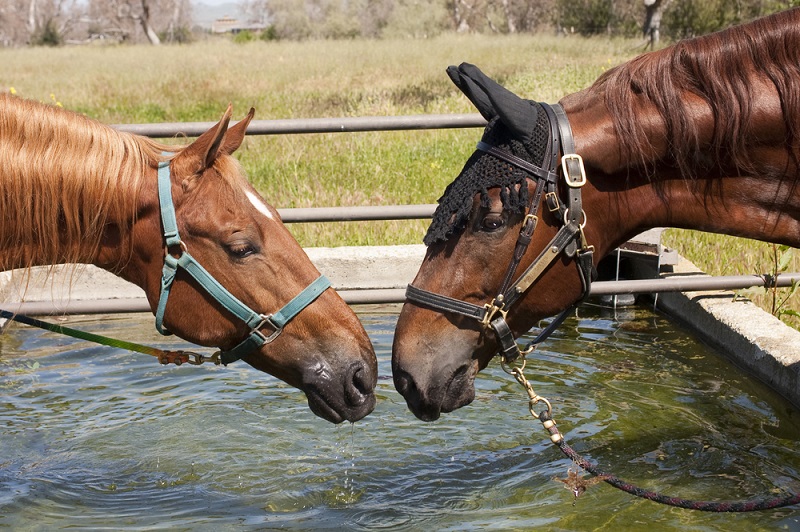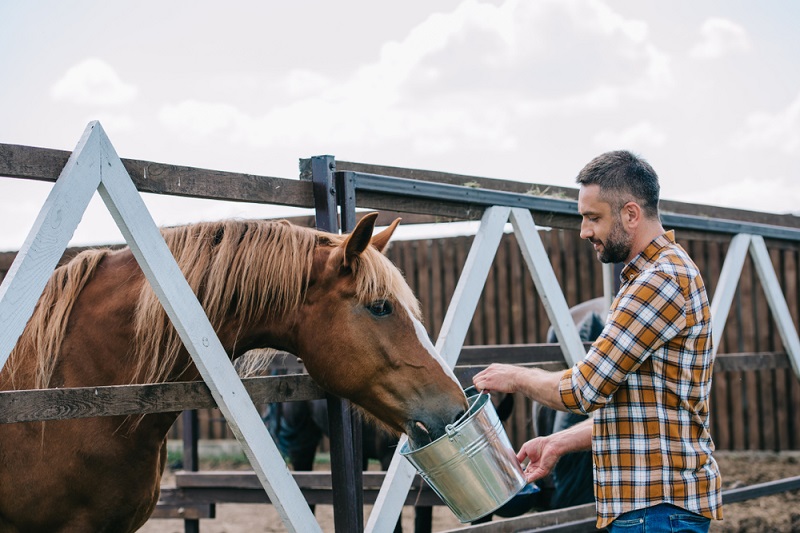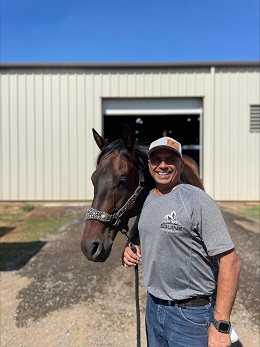Every horse owner knows and fears the name: Strangles. This highly contagious disease can strike any horse at any time, leading to a severe infection of the upper respiratory tract. It’s caused by a bacterium called Streptococcus equi, which spreads easily through contact with infected horses or contaminated objects like clothes and feed.1
Strangles in horses causes unpleasant symptoms like fever, nasal discharge, swollen lymph nodes, abscesses, and the characteristic strangled breathing sounds that give it its name.
If your horse has been exposed to this nasty disease, don’t panic. It’s rarely fatal, and with the right treatment, your horse should recover fully in no time.
In this article, we’ll tell you everything you need to know about strangles, including how to recognize it, treat it, and keep it from spreading to the rest of the herd.
Understanding Strangles
Strangles is a common bacterial infection that can occur in horses, mules, cows, donkeys, ponies, and even zebras. Sick animals can be contagious without showing symptoms for 3 to 8 days, and they can spread the illness in several ways:2
- Nose-to-nose contact
- Sneezing and coughing
- Drainage from the eyes or nose
- Discharge from abscesses
Contaminated objects can also harbor the bacteria for several days and up to a month or more in damp areas.3 Objects that can indirectly spread the bacteria include:
- Feed buckets
- Water troughs
- Tack
- Clothes and shoes
- Fencing, doors, housing, etc.
Strangles can affect animals at any age, but younger horses are the most likely to get seriously ill. Older horses typically have some immunity from previous exposure that provides protection from the more adverse side effects. Foals have additional immunity provided by their mother’s milk that lasts for several months after weaning.1

Symptoms of Strangles
How do you know if your horse is suffering from strangles and not another respiratory condition such as equine flu, rhinitis, or heaves? Here are some telltale signs to watch for:
- Fever over 102°F and as high as 106°F
- Nasal discharge, often starting clear and becoming thick and yellow
- Swollen, painful lymph nodes, especially under the jaw and throat
- Pain and difficulty extending and moving the head and neck
- Holding the head in unusual positions due to discomfort
- Difficulty breathing and swallowing due to lymphatic inflammation
- Abscesses on the head and neck that may swell and rupture
- Loss of appetite
- Coughing
These symptoms can vary in severity depending on your horse’s age and general health, as well as their immune status. Horses that have been exposed to strangles previously generally don’t become as ill when they are exposed again.
Complications of Strangles
If your horse has strangles, it’s most likely they only need rest and care to recover. However, in about 20% of cases, strangles can lead to more serious complications.3 These can include:
- Metastatic strangles – This complication occurs when abscesses form internally in areas like the lungs, liver, spleen, and brain.1 If abscesses rupture in these areas, they can cause sepsis or death.
- Swelling of the airway – In severe cases, swelling of the lymph nodes can block the airway and cause suffocation.
- Purpura hemorrhagica – This is a rare condition in which blood vessels become inflamed and leaky, causing swelling under the skin.4
8 Tips to Treat and Prevent Strangles
If you suspect your horse has strangles, it’s important to act quickly to prevent spread and help your affected horse recover. Here are 8 steps to treat a case of strangles effectively and responsibly:
#1 Create a Quarantine Area
Since strangles is extremely contagious, it’s essential to isolate your sick horse from other animals as soon as possible. Choose a separate stall or paddock that’s far from your main barn and has good ventilation. Good drainage is also important, since the bacteria that causes strangles can live for up to a month in moist areas and standing water.
#2 Follow Good Hygiene and Sanitation Protocols
You’ll need to use caution to keep your affected horse from infecting others. Be sure to:5
- Use separate tools and equipment for the isolated infected horse, such as buckets, feeders, brushes, etc.
- Disinfect tools with a disinfectant containing glutaraldehyde or chlorhexidine after each use.
- Change your clothes and wash your hands before caring for uninfected horses.
- Don’t allow other horses to visit your property until the infection is cleared up.
- Warn visitors such as vets, farriers, and other horse owners that you have an active case of strangles before they enter the premises.
#3 Let Your Horse Rest and Recover
In most cases, horses will recover from strangles on their own. They may also build stronger immunity if they recover without the use of antibiotics. Generally, you can handle a case of strangles without veterinary assistance as long as you:
- Observe your sick horse carefully to make sure they’re eating and drinking normally
- Check their temperature twice daily to monitor fever progression
- Watch for signs of serious illness such as labored breathing or high fever that persists for more than a few days

#4 Treat Abscesses
Abscesses caused by strangles are usually not a serious health risk to the infected horse. But if the abscesses fail to come to a head and rupture on their own, they can block the airway. This can cause pain and difficulty breathing. In some cases, it can even require surgical drainage or a temporary tracheotomy.
To avoid these complications, you should:1
- Apply hot packs to swollen lymph nodes to help draw the abscess to the skin’s surface
- Clean and flush open abscesses with an antimicrobial disinfectant that’s safe for use on horses
- Flush the abscess daily to keep it open and encourage drainage and healing
#5 Consult Your Veterinarian
If your sick horse’s symptoms seem to be causing severe discomfort or loss of appetite, it’s time to seek veterinary assistance. Your vet can:
- Diagnose the infection to be certain it is caused by Streptococcus equi
- Prescribe an appropriate treatment plan, including antibiotics or IV fluids if necessary
- Monitor your horse for complications
- Lance abscesses that aren’t draining on their own
- Perform nasal swab and blood test on your other horses to help you identify any that may be carrying the disease without showing symptoms
#6 Use Antibiotics with Care
Some experts believe that antibiotics can weaken the horse’s immune response and leave them more likely to be reinfected. Antibiotics are usually only necessary for horses that have:5
- Trouble breathing or swallowing
- High fever that doesn’t break
- Poor energy and appetite
#7 Continue Isolation
To determine when it’s safe to return your horse to the herd, keep in mind:
- Most horses continue to shed bacteria for 2 or 3 weeks after the illness appears
- Some can be infectious for up to 6 weeks
- S. equi bacteria can live on surfaces and in moist areas for several days to a month or more
Typically, infected horses should stay in strict isolationfor at least 4 weeks. Your vet can provide you with specific guidance and test your horse using nasal swab to ensure that they are no longer contagious.

#8 Be Aware of Silent Carriers
In most cases, once a horse has recovered fully it will no longer be able to spread the disease. However, some horses continue to carry the bacteria in their guttural pouch (air-filled sacs in the throat) without showing any signs of illness. They can continue to shed bacteria off and on, sometimes for years.
In an established herd, having a carrier present may actually help the group build up lasting immunity.1 However, you’ll need to use caution when introducing new horses. Proceed with care whenever you introduce a new horse into an established group, and remember that younger horses are especially vulnerable to severe infections.
Your vet can help you determine if one of your horses is a silent carrier. If so, they may need antibiotic treatment and flushing of the guttural pouch to remove the infection completely.
To Vaccinate or Not to Vaccinate
Vaccination is one way to prevent strangles in horses, but it isn’t a perfect solution. Your vet may or may not recommend vaccination based on your horse’s health and other risk factors.
Horses shouldn’t be vaccinated if they had strangles within the past year, or if they currently have strangles. Your vet should perform blood work to test for strangles antibodies before deciding whether to vaccinate.1
Some of the pros of vaccination include:
- Reduction of the severity of the disease if your horse does contract strangles
- Reduces the shedding of bacteria and the risk of spreading the disease to others
Vaccination cons to consider include:1
- The vaccine doesn’t provide full protection against catching strangles—some vaccines only prevent 50% protection
- Vaccination has frequent side effects, such as abscesses, respiratory problems, and purpura hemorrhagica
- Vaccinations can cause outbreaks of strangles if not handled with care when injections are given
To Keep Your Barnyard Healthy and Clean, Choose Vetericyn
Strangles is a serious condition that needs to be handled carefully to prevent spread, but it’s also very treatable. If your horse has strangles, a full recovery is likely with a bit of extra TLC. Be sure to keep abscesses clean to speed healing and prevent the spread of contagious discharge to your other animals.
Vetericyn makes it easy to flush and disinfect abscesses quickly and effectively.
So, if you are worried about how to treat fungal infection horses like horse thrush and conditions like strangles, our gentle, antimicrobial formula fights infection without antibiotics. And it doesn’t sting or burn, so you can help your horse recover faster without causing additional stress and discomfort. You can also take a look at our wide array of other products and resources, such as the protocol for healing a horse hoof abscess. Choose Vetericyn to get your horse on the road to recovery toda
 Reviewed by Solomon Benarroch, Veterinarian
Reviewed by Solomon Benarroch, Veterinarian
Solomon Benarroch DVM has been a practicing veterinarian for over 30 years. His primary focus has been in equine soundness and performance sports medicine. Originally from Winnipeg, Canada he attended college at the Western College of Veterinarian Medicine. And completed an internship at the University of Minnesota. He is the father of three kids and when he isn’t working (which is rare), he enjoys traveling, cooking, and spending time with friends and family.
Sources:
- Journal of Veterinary Internal Medicine. Streptococcus equi Infections in horses: Guidelines for treatment, control, and prevention of strangles—revised consensus statement. https://www.ncbi.nlm.nih.gov/pmc/articles/PMC5867011/
- Farmed Animal Antimicrobial Stewardship Initiative. Transmission of strangles. https://www.amstewardship.ca/faast-reviews/equine-industry/transmission-of-strangles/
- Horse and Hound. Strangles: What is it, how to spot the signs, plus a new vaccine to help protect your horse. https://www.horseandhound.co.uk/horse-care/vet-advice/strangles-in-horses-305828
- University of Minnesota Extension. Purpura hemorrhagica: A bad sequel to strangles. https://extension.umn.edu/horse-health/purpura-hemorrhagica-bad-sequel-strangles
- Merck Veterinary Manual. Strangles in horses. https://www.merckvetmanual.com/respiratory-system/respiratory-diseases-of-horses/strangles-in-horses